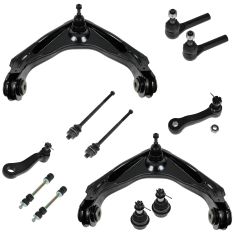1ASFK03858-Chevrolet GMC Hummer Front 13 Piece Steering & Suspension Kit TRQ PSA59437

Replaces
2010 Chevrolet Silverado 3500 HD Front 13 Piece Steering & Suspension Kit TRQ PSA59437

Product Reviews
Loading reviews
3.57/ 5.0
7
7 reviews
August 30, 2017
Fast shipping good quality right fit for the vehicle I am happy whit the service all the way
Chinese imitation parts
September 1, 2017
I was disappointed with the difference in the parts in this kit and the original parts I removed from my truck. The originals were worn out sure, but they were beefy. The OEM parts were much more robust, thicker metal and heavier than the replacements. I suppose I should have expected it for the price. Next time I will buy the Moog parts rather than these.
Steering kit
February 23, 2018
Everything included was a great value. All products fit like they were supposed to. The only thing I wish was different is that the parts were greaseable for service life. All in all great product and I will continue ordering parts here.
Cheep junk, stay away
December 6, 2019
No grease fittings and one of the ball joints came in pieces. Not a good idea.
Reasonable quality
October 11, 2020
Everything looked and installed like oem. I really wish the parts came with zerk fittings because these didn't have much grease in the joints from the factory. I had to remove the boots and pack more in for peace of mind. The price is unbeatable for what you get and YES, these parts are made in China. Virtually all aftermarket parts are these days. I love the lifetime warranty, hopefully they hold up a long time.
January 18, 2021
Fast delivery, right part and great price l really satisfied thanks .
Steering kit parts
February 2, 2022
Steering kit parts were delivered very fast. All parts fit like oem, except no grease fittings. Thats ok with me because of the warranty. We will see how long they hold up.
Customer Q&A
No questions have been asked about this item.
Chevrolet is a registered trademark of General Motors Company. 1A Auto is not affiliated with or sponsored by Chevrolet or General Motors Company.
See all trademarks.



























